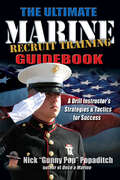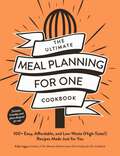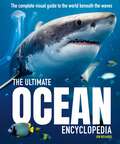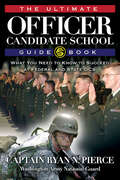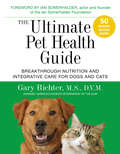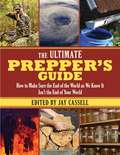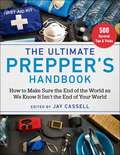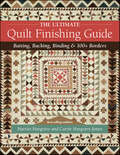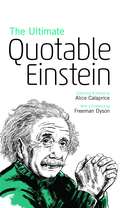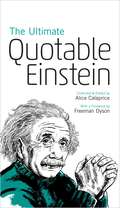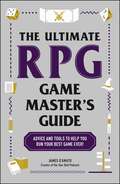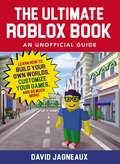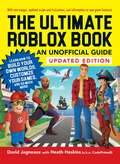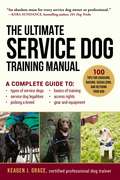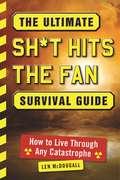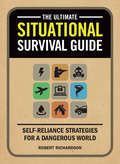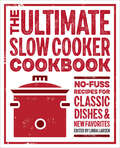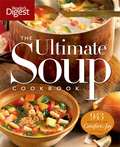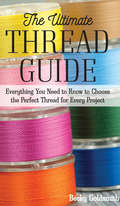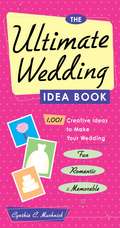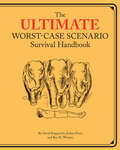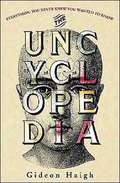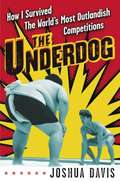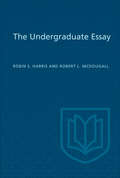- Table View
- List View
The Ultimate Marine Recruit Training Guidebook: A Drill Instructor’s Strategies & Tactics for Success
by Nick PopaditchThe transition from civilian to that of a Marine is a process unlike any other in any branch of the military. As any potential recruit can imagine, Marine recruit training is difficult and challenging. Its purpose is to mold a Marine from the inside out. Nick “Gunny Pop” Popaditch is best known as the “Cigar Marine” and author of Once a Marine, a candid memoir about his service as a tank commander in Iraq, his horrific wounding in the first battle of Fallujah (where he was hit in the head by a rocket-propelled grenade), and his long and difficult recovery. Gunny Pop has experienced the Marine recruit training process from both perspectives: as a new recruit and as a drill instructor. This new book brings together his nearly 16 years of Marine Corps expertise. The Ultimate Marine Recruit Training Guidebook is a comprehensive, practical, and easy-to-follow guide written specifically for every new or prospective recruit about to enter basic training. Gunny Pop offers step-by-step instructions and solutions, including helpful charts and graphics, for how to prepare both physically and mentally for boot camp. Written by a Marine who experienced it firsthand many times over, Gunny Pop explores what recruits will be asked to do (and in many cases, explain why) and the motivating forces behind drill instructor lessons and behavior. The Ultimate Marine Recruit Training Guidebook was written by a Marine and former drill instructor for young men and women who want to become one of the few and the proud. No one should undertake Marine recruit training without having read this book. About the Author: From East Chicago, Indiana, Nick Popaditch enlisted in the Marine Corps in 1986. He was wounded while commanding a tank in Fallujah (Iraq) in 2004 and medically retired from the Marines in 2005 at the rank of Gunnery Sergeant. “Gunny” and his wife April have two children, Richard and Nicholas. They reside in Chula Vista, California.
The Ultimate Meal Planning for One Cookbook: 100+ Easy, Affordable, and Low-Waste (High-Taste!) Recipes Made Just for You (Ultimate for One Cookbooks Series)
by Kelly JaggersPlan your weekly meals while saving time and money with these 100+ recipes perfect for every solo chef trying to build a delicious, cost-effective, low-waste meal plan.Meal planning for one can feel daunting…especially if you want to avoid tons of leftovers and food waste while still making delicious single-serving meals. The good news is that The Ultimate Meal Planning for One Cookbook is here to help with easy-to-use meal plans and over 100 recipes that are designed for meal planning for one. This book allows you to make over 100 delicious, one-to-two-serving recipes for every meal from breakfast to dinner and everything in between. And, not only will you find tasty recipes designed for one, you&’ll also learn to use them to design your own weekly meal plans. Learn how to avoid eating the same old leftovers over and over throughout the week, how to utilize your ingredients as much as possible so nothing goes to waste, and to enjoy delicious versions of your favorite dishes, no matter the occasion. Whether you live alone or are just searching for the perfect meal for yourself, cooking solo need never be boring (or repetitive and wasteful!) again.
The Ultimate Ocean Encyclopedia: The complete visual guide to ocean life (Ultimate Encyclopedia #3)
by Jon RichardsThis new and unique encyclopedia is an amazing new visual guide to the planet's seas and oceans. Using amazing photography and cutting edge CG images, readers can explore every aspect of our oceans, from the submarines that explore them to the vast array of life that lives in them.Discover the plants and animals that exist in every ocean habitat, from the shore to the lowest trenches. You'll learn about sealife including crustaceans, coral, anenomes, every kind of fish, as well as mammals like sealions, dolphins and orcas, and ocean giants like the Blue Whale.Readers will also be able to see how humans have lived with the ocean for millennia, and how our actions today can doom or save our amazing oceans in the years ahead. This brand new encyclopedia is packed with stunning images that truly bring the wonder and majesty of the world's oceans to life.
The Ultimate Officer Candidate School Guidebook: What You Need to Know to Succeed at Federal and State OCS
by Ryan N. PierceA comprehensive guide to the process of applying and earning your commission. Are you a former soldier, sailor, or airman who left the service without making the most of your potential? Are you a leader in the civilian sector who knows you have more to give back to the country you love? If so, you should consider entering the Army, Army Reserves, or Army National Guard, earn your commission as a Second Lieutenant, and begin or restart an exciting career as a leader in the world's best military. The Ultimate Officer Candidate School Guidebook explains everything you need to know to achieve these goals. Earning the right to become a US Army officer is an honor and a privilege, and the deck is stacked against those over twenty-five because of the rigorous, time-consuming training. However, you can attend OCS to earn a commission as a Second Lieutenant if you: are between eighteen and fortyhave an undergraduate degree from an accredited collegehave or can attain a minimum GT score of 110can pass an Army Physical Fitness Test Getting accepted to OCS is not automatic, and your choice of when and where to enter is limited. Federal OCS, held at Fort Benning, Georgia, and the many state traditional and fast-track programs offer potential officer candidates a choice about how and when to earn their commission. In this book, an OCS graduate and former TAC Officer offers nineteen chapters of information to guide potential candidates down the path of earning a commission in the Army. It covers everything from the application process, to stressers from TAC officers while attending OCS, to deciding what branch to choose upon earning your commission. It even includes pages with pre-made terrain model kits to assist you while attending OCS, for those who are serious about leadership and finishing strong. Are you up to the challenge?
The Ultimate Pet Health Guide: Breakthrough Nutrition and Integrative Care for Dogs and Cats
by Gary RichterAs a holistic veterinarian and scientist, Dr. Gary Richter helps dog and cat owners to navigate the thicket of treatment options and separate the fact from the fiction. He wants us to use what actually works, not just what Western science or alternative medicine say "should" work.This multifaceted approach to health is known as integrative medicine. Dr. Richter examines traditional medicine from many cultures alongside modern medical techniques, describing the best of complementary care and the best of conventional veterinary medicine. Every treatment he recommends has the backing of scientific research or years of successful outcomes in his clinical practice. After explaining the treatment, he offers specific recommendations for an integrative approach to common diseases, including allergies, skin conditions, diabetes, heart disease, and cancer.A holistic approach to health includes nutrition, as it sets up the foundation for your pet&’s health. Dr. Richter cuts through the hype in the pet-food world and explains how to choose the best commercial foods and supplements, and even includes both raw and cooked dog- and cat-food recipes for general diet as well as to treat specific needs. He also explains how we can use the right foods and supplements to "hack" the body&’s processes, including the immune system.
The Ultimate Prepper's Guide: How to Make Sure the End of the World as We Know It Isn?t the End of Your World
by Jay CassellThe Ultimate Preppers' Guide is packed with practical approaches, step-by-step instructions, and how-to explanations for disaster and emergency preparation. Knowledge maps, flow charts, and templates provide important information at a glance and walk you through your decisions on personalizing and customizing disaster preparation for you, the family, and your business. The Ultimate Preppers' Guide is logically organized, easy to reference, and simple to understand. It provides diverse coverage of disaster prep topics, including a comprehensive look at disaster first aid and medical problems where there are no responders or hospitals immediately available. This book brings you up to date on emerging prep trends and technologies and examines what works and what doesn't. It explains how to prep with the budget you have and with many of the materials you already have at hand. It includes chapters on basic preparedness, communications, resource conservation, power and energy, emergency heating and cooling, water, food and nutrition, shelter, evacuation, public health, special needs, and specific hazards. This book will not just get you ready beforehand. When a disaster has happened, it will provide ideas for surviving, coping, and recovering.
The Ultimate Prepper's Handbook: How to Make Sure the End of the World as We Know It Isn't the End of Your World
by Jay CassellAre you prepared for the end of the world as you know it? It can be all too easy to think of disaster as something that happens to others. But the world is a volatile place, and despite our best efforts we can quickly find ourselves in dangerous or even deadly situations. Proper preparation can ensure that, when that does happen, we have the tools and knowledge necessary to survive. This guide is the ultimate reference on how to prepare for disaster and how to respond when it strikes. Through it you will learn the basics of how to survive and how to reduce your reliance on modern conveniences so that, no matter what happens, you won&’t be caught unprepared. The information gathered in this volume includes knowledge and advice from experienced preppers, outdoorsmen, and survival experts. It will help everyone from the beginner trying to start a food pantry to the seasoned veteran who is looking for a few extra tips and tricks to become more self-reliant. The Ultimate Prepper&’s Handbook contains information and techniques concerning:Starting a food pantryHome and self-defenseEmergency first-aidCarrying a concealed firearmDealing with specific disastersMedical assessmentsBug out bagsSurvival sheltersForaging, hunting, and trappingFinding waterReducing energy useGrowing your own foodThis book will not just get you ready beforehand—when a disaster happens, it will provide ideas for surviving, coping, and recovering.
The Ultimate Quilt Finishing Guide: Batting, Backing, Binding & 100+ Borders
by Harriet Hargrave Carrie Hargrave-JonesMaster Quilt Borders, Backing, and Bindings! Finish your quilt strong with a polished and professional touch! From borders to binding (with batting in between) this is the perfect reference tool with step-by-step instructions on how to complete each finishing touch. Go from ordinary to extraordinary with over 100 different border options to give your quilt pizzaz and explore numerous ways on how to bind a quilt. Plus, you’ll never ruin a quilt again with the wrong choice of batting as tips and tricks will give you the insight and confidence you need to always make the right decision. Take all the guesswork out of finishing quilts with this essential guide! Make more than 100 different borders with step-by-step instructions on how to piece and add them to your quilt top Learn numerous ways to bind your quilt from straight and bias binding to prairie points and beyond This guide is the perfect lifelong reference tool that can be referred to again and again
The Ultimate Quotable Einstein
by Albert Einstein Freeman Dyson Alice CalapriceHere is the definitive new edition of the hugely popular collection of Einstein quotations that has sold tens of thousands of copies worldwide and been translated into twenty-five languages. The Ultimate Quotable Einstein features 400 additional quotes, bringing the total to roughly 1,600 in all. This ultimate edition includes new sections--"On and to Children," "On Race and Prejudice," and "Einstein's Verses: A Small Selection"--as well as a chronology of Einstein's life and accomplishments, Freeman Dyson's authoritative foreword, and new commentary by Alice Calaprice. In The Ultimate Quotable Einstein, readers will also find quotes by others about Einstein along with quotes attributed to him. Every quotation in this informative and entertaining collection is fully documented, and Calaprice has carefully selected new photographs and cartoons to introduce each section.Features 400 additional quotations Contains roughly 1,600 quotations in all Includes new sections on children, race and prejudice, and Einstein's poetry Provides new commentary Beautifully illustrated The most comprehensive collection of Einstein quotes ever published
The Ultimate Quotable Einstein
by Albert EinsteinThis is the definitive edition of the hugely popular collection of Einstein quotations that has sold tens of thousands of copies worldwide and been translated into twenty-five languages.The Ultimate Quotable Einstein features roughly 1,600 quotes in all. This paperback edition includes sections unique to the ultimate collection--"On and to Children," "On Race and Prejudice," and "Einstein's Verses: A Small Selection"--as well as a chronology of Einstein’s life and accomplishments, Freeman Dyson’s authoritative foreword, and commentary and descriptive source notes by Alice Calaprice.
The Ultimate RPG Game Master's Guide: Advice and Tools to Help You Run Your Best Game Ever! (Ultimate Role Playing Game Series)
by James D’AmatoUp your game with everything you need to run your next tabletop roleplay game with expert advice, gameplay guidance, and playable content from RPG expert James D&’Amato.How do I make combat more interesting? How do I encourage my players to role-play? How do I avoid my sessions ending in disaster? Leading an RPG can be a challenge, but The Ultimate Game Master&’s Guide is here to help! With advice from RPG expert James D&’Amato, you&’ll find answers to all these questions and more, along with guidance for bringing your game to life from behind the GM screen. James covers everything you need to know to bring your GM game to the next level including: -How to make player decisions meaningful -How to add more roleplay to your adventure -How to keep combat interesting—and memorable -How to make NPCs dynamic, but keep them from stealing the show -And so much more! Add excitement to your game and keep players fully engaged with The Ultimate RPG Game Master&’s Guide.
The Ultimate Roblox Book: Learn How to Build Your Own Worlds, Customize Your Games, and So Much More! (Unofficial Roblox)
by David JagneauxBuild and create your own Roblox world with this easy and fun guide!Roblox, the largest user-generated online gaming platform that allows users to create and share their own game worlds and gaming creations, has taken the digital world by storm. There are so many games and social worlds to create with the platform, and this guide gives you the advice you need to get started. With everything from instructions for playing the games to tips on creating your own games and worlds to the basics of scripting your own unique content, The Ultimate Roblox Book can help you to become a top Roblox designer.
The Ultimate Roblox Book: Learn How to Build Your Own Worlds, Customize Your Games, and So Much More! (Unofficial Roblox)
by David Jagneaux Heath HaskinsBuild and create your own Roblox world with this updated, easy-to-use guide.Roblox, the largest user-generated online gaming platform that allows users to create and share their own game worlds and gaming creations, has taken the digital world by storm! With updated screenshots and instructions, The Ultimate Roblox Book, Updated Edition provides brand-new information on game changes and the latest features so you can make the most out of your Roblox game. With everything from instructions for playing the games to tips on creating your own worlds to the basics of coding, this updated guide gives you all the tools you need to get started.
The Ultimate Service Dog Training Manual: 100 Tips for Choosing, Raising, Socializing, and Retiring Your Dog
by Keagen J. GraceA One-Stop Shop for Anyone Interested in Learning How to Obtain, Train, Raise, and Live With a Service Dog.The Ultimate Service Dog Training Manual is the essential resource for laypeople, handlers, and trainers alike who deal with service dogs. Covering everything you need to know about obtaining, training, and living with service dogs, this comprehensive guide provides practical dos and don'ts, tips and tricks, and advice on raising the perfect service dog for various situations. Complete with illustrative photos, tips, sidebars, and detailed information, Including the history of service dogs, the legalities of where they are allowed in public and who is permitted to have them, what rights are in place to protect them, and more, this service dog bible covers service dog topics like: What handlers want you to knowThe path to becoming a service dogService dog jobs, from allergen alert dogs to psychiatric and seizure dogsCosts of owner-training&“Fake&” or under-trained service dogsWhat service dogs should and should not do in publicWhat makes a dog unsuitableOverview of standards, requirements, certifications, and gearTask training, from opening doors to assisted pick-up, and moreService dog socializationService dogs at work and schoolService dog retirementThe difference between service dogs, therapy animals, and emotional support animalsAnd more!
The Ultimate Sh*t Hits the Fan Survival Guide: How to Live Through Any Catastrophe
by Len McDougallThe world is changing before our very eyes. Today we deal with serious social, political, economic, and environmental issues that affect our everyday lives. With this change we must adapt, and by adapt we mean be prepared to survive when things go south and society crumbles.Len McDougall has spent his entire life-almost sixty years-learning the nuts and bolts of staying alive under adverse conditions. And now more than ever will we need to take his lessons seriously, as understanding what to expect and how to adapt will increase the odds for survival.The Ultimate Sh*t Hits the Fan Survival Guide is just that. Featuring methods that have been personally tested through hard, field-proven experiences, you will learn everything needed to survive when things fall apart and you’re left to fend for yourself.Included in this book are many lessons on survival, including:The best method of starting a fire.Obtaining portable water from any body of water or stream without using tools, fire, or chemicals.The simplest method for catching a meal.Surviving in possible combat, whether through weapon training or hand-to-hand.And so much more.Times are indeed changing, and it’s now a necessity to be prepared for whatever obstacles may come your way. The Ultimate Sh*t Hits the Fan Survival Guide is just that; a collection of tips, tricks, lessons, and knowledge from a professional survivalist that will make sure you will not only survive, but thrive when catastrophe strikes.
The Ultimate Situational Survival Guide: Self-Reliance Strategies for a Dangerous World
by Robert RichardsonSituational Survival Means Being Ready for Whatever Life Throws At You The most important "tool" in your emergency preparedness kit is a solid mindset cultivated around survival. In order for your instincts and reflexes to keep you alive when life throws an unexpected and dangerous situation your way, you must already be mentally prepared to face a potentially life-threatening challenge. This book will teach you how to do just that. The Ultimate Situational Survival Guide covers: creating home safety plans, dealing with natural disasters, planning for transportation issues, identifying urban threats and dealing with them, financial preparedness, being prepared for terrorist attacks and other man-made disasters, and coping with disease in many of these scenarios. Inside you'll find: fresh, real-life approaches to survival in the 21st century--not revised material taken from government websites a practical preparedness approach to everyday life including home safety, vehicle preparedness and financial security techniques and skills needed to survive criminal and violent attacks along with hostage and active shooter situations These are the kinds of threats you need to start preparing for now if you want to survive. What are you willing to do to guarantee your survival? What length are you willing to go to guarantee your family's survival? Take this book home and get started preparing today!
The Ultimate Slow Cooker Cookbook: No-Fuss Recipes for Classic Dishes and New Favorites
by Linda LarsenPrepped quickly, cooked slowly—wholesome, hearty meals for any day of the week There's a reason slow cookers have been a staple in American homes for more than half a century: with just a few minutes of prep in the morning, you can have a delicious dinner waiting for you when you get home. And with The Ultimate Slow Cooker Cookbook, you'll never get bored with your options. From healthy breakfasts to soups and stews—even enticing desserts—this book has it all! In the first chapter of this slow cooker cookbook, you'll get to know your favorite appliance even better, including what settings are best for each dish, a primer on safety, and a few tricks to maximize your slow cooker. Then dive into 225+ creative, simple, and timeless recipes that are designed for maximum flavor for minimum work. From comforting classics like Potato and Sausage Frittata to Moroccan Lamb Stew or even Korean Short Ribs and Carrots, see how this slow cooker cookbook can help you make even more with your slow cooker. Inside The Ultimate Slow Cooker Cookbook you'll find: Lighten up—No canned soups or super-processed foods in this slow cooker cookbook! Plus, a low-calorie label makes healthy options easy to find. Modern meals—Whether you need a casual family meal or dinner party fare, these recipes are fresh and innovative. Weeknight heroes—Choose from scores of meals that are specifically designed to take 15 minutes or less of prep and cook for 8 hours, so dinner is ready when you are. Make the most—and the most delicious meals—out of your slow cooker with The Ultimate Slow Cooker Cookbook
The Ultimate Soup Cookbook
by Editors of Reader's DigestThere is nothing more enjoyable or adaptable than soup. It can be prepared hot or cold-eaten before, after, between, or as a meal-and served with almost anything. The Ultimate Soup Cookbook is the definitive collection of recipes for soup lovers everywhere. Featuring over 900 recipes that include specially selected soups-ranging from hearty chowders and stews to creamy vegetarian soups and chilies-plus dozens of recipes for breads, biscuits, rolls, salads, quesadillas, and more, this cookbook provides just the right soup or stew for any occasion. Looking to take the chill off a cold winter's night? Try a Cheddar Cheese and Broccoli Soup or a Beef-Vegetable Soup. For a sweltering summer evening choose from refreshing coolers like Artichokes and Tomato Soup or Carrot Soup with Dill. For an impressive dinner-party starter try Asparagus Soup or Shrimp and Fennel Bisque. If time is short, you'll find hundreds of sure-to-please 30- minutes-or-less soups such as One-Pot Chili, ready in 20 minutes; Quick Vegetable-Beef Soup, ready in 30 minutes; and Stir-Fried Pork Soup, which takes just 10 minutes to prepare. The Ultimate Soup Cookbook provides you with simple step-by-step- instruction for each recipe, plus icons that make it simple to select just the right recipe-including Easy: 10 minutes to prepare; Quick: Ready to eat in 30 minutes; One-Dish: Contains protein, vegetables, and good carbohydrates for a complete meal; Healthy: High in nutrients, low in bad fats and empty carbohydrates; and Slow Cooker: Easy to adapt for slow cookers by cutting down on liquids. From simple starters to hearty soups that work as filling meals, here are soup recipes that you're sure to use again and again. They're easy to make, and most can be prepared with ingredients found in your local supermarket.
The Ultimate Thread Guide: Everything You Need to Know to Choose the Perfect Thread for Every Project
by Becky Goldsmith“[A] handy, in-depth guide . . . an attractive and useful reference for those passionate about sewing and other thread-based crafts.” —Publishers Weekly (starred review)Always choose the right thread! This amazing reference guide features a convenient thread use key that shows the most common uses for the wide variety of threads commonly used by quilters and sewists. This valuable information will help you determine which one is right for your project. Plus, get the inside scoop on thread types and fibers, thread weight, choosing the correct sewing machine needle, and how thread is made.Learn about the most important features of specific threads (grouped by thread manufacturer)The perfect on-the-go referenceTry out new products and new techniques with confidence
The Ultimate Wedding Idea Book: 1,001 Creative Ideas to Make Your Wedding Fun, Romantic & Memorable
by Cynthia Clumeck MuchnickCreative, Romantic, and Exciting Ideas for Your Big DayAre you looking for fabulous and fun suggestions that will make your special day more special? This vibrant little wedding companion will show you how to add spice and pizzazz plus romance and allure to your wedding day to create memories that will stay with you forever. At your fingertips are 1,001 spectacular hints and tips such as: ·Unique wedding and reception locations ·Modern twists on traditional weddings ·Creative, budget-minded alternatives ·Writing romantic and personalized vows ·Hip bachelor and bachelorette parties ·Exciting theme weddings ·And so much more! "A multitude of fresh ideas, from announcing the engagement to planning the honeymoon. This smart, practical, and creative advice is sure to inspire many engaged couples."--Diane Forden, editor in chief, Bridal Guide magazine"Wow! A great alternative to the Internet! A very easy-to-read book that lists more ideas than a bride could ever use!"--Beverly Clark, author, Planning a Wedding to RememberFrom the Trade Paperback edition.
The Ultimate Worst-Case Scenario Survival Handbook (Worst-Case Scenario)
by Joshua Piven David Borgenicht Ben H. WintersFour hundred scenarios from all of the bestselling books in the series—with dozens of new entries—from being kicked by a zebra to breakup texts.With over 10 million copies sold worldwide, the Worst-Case Scenario series has been preparing readers for dangers of all kinds for more than a decade. This handsome compendium is truly the ultimate guide for handling life’s inevitable Worst-Case Scenarios, collecting—for the first time—hundreds of the best and most crucial scenarios from across the entire 26-book series, along with dozens of all new and expanded scenarios, charts, and expert tips. Topical, tabloid-style pages explore more than 100 subjects, from storms to stampedes to technology failures and beyond, with special sections highlighting critical information on starting fires, animal encounters, emergency signals, “Can I eat that?” questions, and more. Packed with expert advice and sturdy enough to stop a tiger bite, this gifty tome will keep longtime fans and new initiates safe and entertained in equal measure.Praise for the Worst-Case Scenario Survival series“What this book lacks in spiritual enlightenment, it more than makes up for with the practical advice you thought you’d never need. Yet it’s only when you read about how to deliver a baby in the back of a taxi, surviving quicksand and mastering awkward lift silences that you realize just how handy a book like this could come in. Some day.” —The Irish Times“There is something for everyone. It has a wide range of scenarios from dangerous to just downright irritating . . . It is fun, witty, entertaining and you learn something along the way too.” —Quill Quotes
The Ultimate: The Great American Arguments Settled Once and for All
by William PoundstoneThe Ultimate is sophisticated fun, literate trivia in the witty, anecdotal and provocative style familiar to Poundstone fans across the country. Here Poundstone establishes objective ways of determining what really is the biggest, the highest, the greatest, and the best.
The Uncyclopedia
by Gideon HaighMake way for this defiantly idiosyncratic, hilariously illuminating compendium of curiosities you never knew you wanted to know! How do you flirt in Turkish? How do you dump someone in Japanese? What are the names of all the animals ever sent into space? These are just some of the fun and insightful oddities that made Gideon Haigh's The Uncyclopedia a hit overseas. The first ever encyclopedia for the curious, The Uncyclopedia is a compendium of illuminating knowledge and a delight for all inquisitive readers. As proved by Schott's Original Miscellany and the enormous rise in popularity of quiz and trivia nights, arcane knowledge and non-essential facts have never been so popular. At last in one convenient volume, everything for knowledge-hungry readers: Lists of Norse gods Suicide notes of the famous All anyone needs to know about How to toast in 10 languages A list of all the men to walk on the moon Twenty Latin mottoes Fortune-telling techniques Neither trivial nor essential, yet always engaging and illuminating, The Uncyclopedia is the reference book referred to purely for the purposes of amusement--and readers just can't put it down!
The Underdog: How I Survived the World's Most Outlandish Competitions
by Joshua DavisJoshua Davis had a dream. He dreamt of being the best. It didn't really matter what he was the best at, he just wanted to be number one, the big enchilada, to say that he had made it. This is how it began: Josh was driving through the Mojave Desert one day when he saw a sign for the American arm-wrestling championship - all comers welcome. He decided to enter. He came fourth, out of four, but this was enough to secure him a place on Team USA and the chance of a show-down with the 'Russian Ripper' at the world championships in Poland (that didn't end very well either). But Josh had tasted the dizzy rush of competition and wanted more. And more turned out to be the most outlandish contests in the world - from bull fighting in Spain and backward running in Italy, to sumo wrestling and the World Sauna Championship in Finland. Joshua's quest is by turns hilarious, harrowing and a little insane, but it is also inspiring - because, after all, every underdog deserves his day.
The Undergraduate Essay
by Robin Harris Robert McDougallThe Undergraduate Essay sets before the student examples of writing from which he can learn what to do and why. Part I of this book consists of six complete essays of average undergraduate length. All are specimens rather than models; these essays are well-written, but they are not faultless. In Part II, the authors define and discuss the principles of sound essay writing by considering in turn the plan, paragraph structure, sentence structure, diction, punctuation, and under the title "The Conventions of Scholarship" the use of footnotes and the preparation of a bibliography. Throughout, the student is urged to study examples, and to think critically and constructively on the problems raised. It follows that The Undergraduate Essay makes no attempt to do the work either of the student of the instructor. It is a text which invites, indeed demands, the co-operative effort of both.
